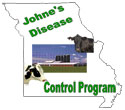Johne's Disease Voluntary Control Program
 The initiative for the Johne's Disease Control Program has three objectives:
The initiative for the Johne's Disease Control Program has three objectives:
- Reduce the possibility of introducing Johne's disease into uninfected herds.
- Minimize the impact of Johne's disease in herds already infected.
- Control existing cases.
Johne's (pronounced "Yo-knees") is a contagious, chronic and usually fatal bacterial infection (Mycobacterium avium subspecies paratuberculosis), a hardy bacteria related to the agents of leprosy and tuberculosis, primarily of the lower small intestine. Johne's most often infects dairy and beef cattle, sheep, goats, and other ruminants by invading the walls of the intestinal tract.
Typical clinical signs include diarrhea (maybe intermittent, maybe ongoing), with a normal appetite, weight loss, decreased milk production, increased incidence of mastitis, prolonged calving interval, emaciation and then death. Several weeks after the onset of diarrhea, a soft swelling may occur under the jaw (bottle jaw). Bottle jaw or intermandibular edema is due to protein loss from the bloodstream into the digestive tract. Animals at this stage of the disease will not live very long, perhaps a few weeks at the most. During that time however, the infected animal may be shedding large amounts of the bacteria in its manure, serving as a source of infection for other animals. Johne's disease should be considered a herd problem as well as an individual problem.
The affected animal is typically exposed to the bacteria when very young. It takes several months to years for the disease to progress to the point where clinical signs appear. Signs are rarely evident until two or more years after the initial infection, which usually occurs shortly after birth. Animals are most susceptible to the infection in the first year of life. Newborns most often become infected by swallowing small amounts of infected manure from the birthing environmentor udder of the mother. In addition, newborns may become infected while in the uterus or by swallowing bacteria passed in milk and colostrum. Animals exposed at an older age, are not likely to develop clinical disease until they are much older than two years.
Johne's Disease Voluntary Control Program Herds
As described in the Johne's Voluntary Control Program Standards cattle herds can achieve 'Negative Status Levels'. There are four levels a herd can achieve; and the probability that a herd is not infected with Mycobacterium avium subspecies paratuberculosis (the causative bacterium for Johne's disease) increases as herds progress through these levels. Level 1 conveys an 85% probability the herd is Johne's free, while Level 4 (the highest level attainable) conveys a 99% probability the herd is Johne's free. A herd that reaches Level 4 has had at a minimum at least 4 years of testing and management in the program.
Cattle herds that are in the Johne's Disease Voluntary Control Program at a Negative Status Level 1 or higher are a good source for breeding stock replacement with respect to Johne's disease and possibly other bovine enteric diseases. Below are the links to the listing of these cattle herds for the State of Missouri. These herds have voluntarily given MDA the permission to list them on this site, feel free to contact them as to Status Level and availability of replacement seedstock for your herd.
Resources
- Johne's Handbook for Veterinarians and Beef Producers
- Johne's Handbook for Veterinarians and Dairy Producers
- How to Do Risk Assessments and Management Plans for Johne's Disease
- Johne's Information Center
- Johne's Information Central
- Uniform Program Standards for the Voluntary Bovine Johne's Disease Control Program
- USDA Johne’s Program Newsletters
